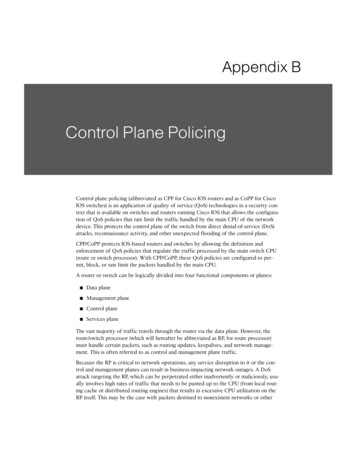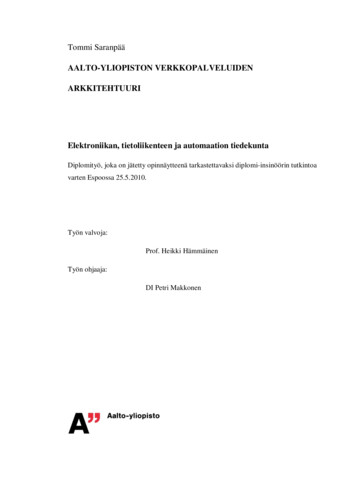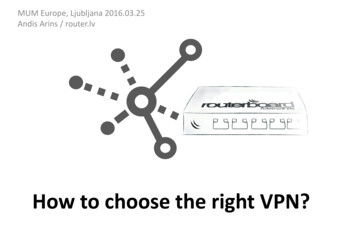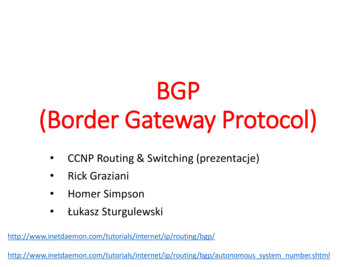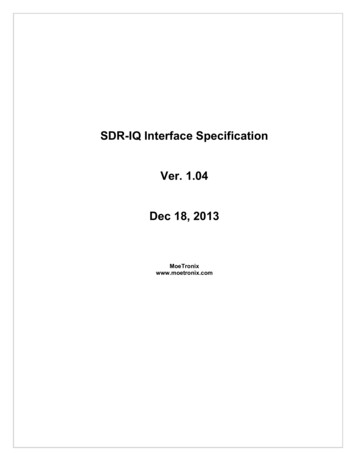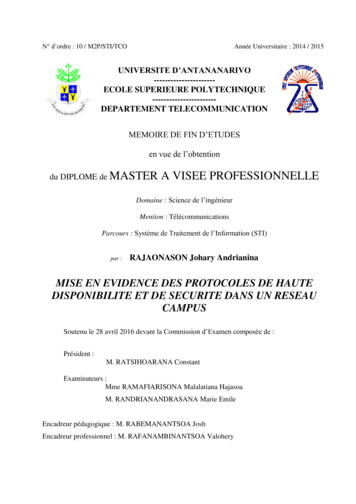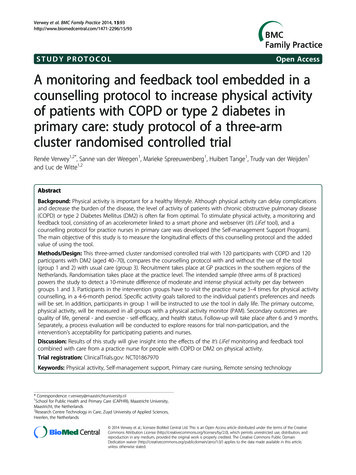
Transcription
Verwey et al. BMC Family Practice 2014, TUDY PROTOCOLOpen AccessA monitoring and feedback tool embedded in acounselling protocol to increase physical activityof patients with COPD or type 2 diabetes inprimary care: study protocol of a three-armcluster randomised controlled trialRenée Verwey1,2*, Sanne van der Weegen1, Marieke Spreeuwenberg1, Huibert Tange1, Trudy van der Weijden1and Luc de Witte1,2AbstractBackground: Physical activity is important for a healthy lifestyle. Although physical activity can delay complicationsand decrease the burden of the disease, the level of activity of patients with chronic obstructive pulmonary disease(COPD) or type 2 Diabetes Mellitus (DM2) is often far from optimal. To stimulate physical activity, a monitoring andfeedback tool, consisting of an accelerometer linked to a smart phone and webserver (It’s LiFe! tool), and acounselling protocol for practice nurses in primary care was developed (the Self-management Support Program).The main objective of this study is to measure the longitudinal effects of this counselling protocol and the addedvalue of using the tool.Methods/Design: This three-armed cluster randomised controlled trial with 120 participants with COPD and 120participants with DM2 (aged 40–70), compares the counselling protocol with and without the use of the tool(group 1 and 2) with usual care (group 3). Recruitment takes place at GP practices in the southern regions of theNetherlands. Randomisation takes place at the practice level. The intended sample (three arms of 8 practices)powers the study to detect a 10-minute difference of moderate and intense physical activity per day betweengroups 1 and 3. Participants in the intervention groups have to visit the practice nurse 3–4 times for physical activitycounselling, in a 4-6-month period. Specific activity goals tailored to the individual patient's preferences and needswill be set. In addition, participants in group 1 will be instructed to use the tool in daily life. The primary outcome,physical activity, will be measured in all groups with a physical activity monitor (PAM). Secondary outcomes arequality of life, general - and exercise - self-efficacy, and health status. Follow-up will take place after 6 and 9 months.Separately, a process evaluation will be conducted to explore reasons for trial non-participation, and theintervention’s acceptability for participating patients and nurses.Discussion: Results of this study will give insight into the effects of the It’s LiFe! monitoring and feedback toolcombined with care from a practice nurse for people with COPD or DM2 on physical activity.Trial registration: ClinicalTrials.gov: NCT01867970Keywords: Physical activity, Self-management support, Primary care nursing, Remote sensing technology* Correspondence: r.verwey@maastrichtuniversity.nl1School for Public Health and Primary Care (CAPHRI), Maastricht University,Maastricht, the Netherlands2Research Centre Technology in Care, Zuyd University of Applied Sciences,Heerlen, the Netherlands 2014 Verwey et al.; licensee BioMed Central Ltd. This is an Open Access article distributed under the terms of the CreativeCommons Attribution License (http://creativecommons.org/licenses/by/2.0), which permits unrestricted use, distribution, andreproduction in any medium, provided the original work is properly credited. The Creative Commons Public DomainDedication waiver ) applies to the data made available in this article,unless otherwise stated.
Verwey et al. BMC Family Practice 2014, ackgroundBecause increased physical activity (PA) has positive effectson prognosis and quality of life [1,2], stimulating PA is animportant element in the treatment of people with chronicdiseases such as chronic obstructive pulmonary disease(COPD) or type II diabetes (DM2) [3,4]. It is, however,a challenge to adhere to guidelines for healthy exercise(at least 30 minutes of moderate activity five days a week)[5,6]. By integrating PA counselling into routine practice,primary care providers can support patients in meetingthis challenge [5,7]. In the Netherlands the majority ofchronically ill patients visit the family practice regularly tomonitor their condition, and it is the task of the practicenurse (PN) to provide lifestyle counselling during thoseconsultations [8,9].The most common method of PA promotion is verbaladvise, followed by print- and computer-based interventions [10]. Interventions incorporating technology that isreadily accessible on a daily basis for monitoring activitylevels, such as computers or mobile phones, can supportcare providers to coach patients in establishing behavioural changes [11]. Those interventions may facilitatelong-term follow-up [12,13], and may be an effective wayto provide PA counselling without increasing the time demands on primary care providers [14].PA counselling has the potential to increase PA levelsin the short term [13]. However, evidence regardingwhich methods of exercise promotion works best in thelong term is still limited [15]. Furthermore, computerbased patient self-management programs, delivered inhealth-supported settings, show the potential for changing health behaviours and improving clinical outcomes, but more well designed trials are warranted totest their effectiveness [16]. Those trials should especially focus on the effects of theory-based interventiondevelopment, combined with the effect of tailored adviseand feedback [17].We therefore, developed and tested a monitoringand feedback tool called It’s LiFe! [18,19] and a corresponding counselling program for primary care nurses(the Self-management Support Program). The basicideas behind this combination are: providing an objectivemeasurement of PA via an accelerometer, collaborativegoal setting and automatic feedback via an application ona smartphone combined with PA counselling by the PN.Results from a feasibility study showed that participantswere positive about the tool. Regarding the effects of usingthe tool, a positive trend was seen: the mean level of PAincreased by more than 10 minutes per day and patientsreported a higher quality of life [20].This paper describes the study protocol of a three-armedcluster randomised controlled trial with 120 participantswith COPD and 120 participants with DM2 (aged 40–70),comparing the Self-management Support Program withPage 2 of 10and without the use of the tool (group 1 and 2) with usualcare (group 3).Objectives and hypothesesThe objective of this randomised controlled trial is to evaluate the longitudinal effects of the It’s LiFe! tool embeddedin a Self-management Support Program (SSP) on 40–70years old patients with COPD and DM2 in primarycare. The primary outcome measure is PA in daily life.Secondary outcome measures are self-efficacy, qualityof life and health status. The main difference that isevaluated is between the whole intervention and usualcare. Additionally, the isolated effect of the tool isevaluated. Apart from the effect evaluation, a processevaluation will be performed, aimed at getting insightinto the adherence to the intervention and the acceptance of the intervention by participating patients andPNs.The main hypothesis is that the whole interventionwill increase PA on a moderate level by at least 10 minutesper day, over a four to six-month period, and to maintainthis increase over three months.Methods/designThis paper was written according to the CONSORT 2010statement: extension to cluster randomised trials [21].Study designThe study is designed as a cluster randomised controlledtrial with GP practices as the unit of randomisation. Tocompare the whole intervention with both usual careand SSP only (to isolate the effect of the tool), the trial hasthree arms: the use of a monitoring and feedback tool embedded in the SSP (group 1), the SSP without the tool(group 2), and usual care (group 3). The CONSORT flowchart (Figure 1) summarises the trial design. The population consists of 120 participants with COPD and 120participants with DM2 from 24 GP practices. Each practice provides 5 COPD patients and 5 DM2 patients, whichmakes a total of 40 patients with COPD and 40 patientswith DM2 from 8 practices per trial arm.EligibilityParticipants between 40 and 70 years old are eligiblewhen they are diagnosed with COPD or DM2, are treatedin primary care, and in the opinion of the PN, do notcomply with the Dutch Norm for Healthy Exercise [22].Additional inclusion criteria for the DM2 patients are aBMI 25 and for the COPD patients: a clinical diagnosisof COPD according to the GOLD-criteria stage 1–3, beingat least six weeks respiratory stable and on a stable drugregimen. Furthermore, patients should have access to acomputer with an internet connection.
Verwey et al. BMC Family Practice 2014, age 3 of 10Assessed for eligibility (n 250 practices)EnrolmentExcluded(n 0)Refused to participate(n 226 practices)Randomised (24 practicesin 2 blocks)Assessed for eligibility 540participantsAllocationAllocated to group 1Tool and SSP(N 8 practices)Received allocated intervention(n potential 80participants).Did not receive allocatedintervention(n XX participants).Will give reasons.Allocated to group 2Allocated to group 3SSPCare as usual(N 8 practices)Received allocated intervention(n potential 80participants).Did not receive allocatedintervention(n XX participants).Will give reasons.(N 8 practices)Received allocated intervention(n potential 80participants).Did not receive allocatedintervention(n XX participants).Will give reasons.Follow-upLost to follow-up(n o practices; potential XXparticipants did notrespond).Discontinued intervention(n 0 practices; potential XXparticipants).Will give reasons.Lost to follow-up(n o practices; potential XXparticipants did notrespond).Discontinued intervention(n 0 practices; potential XXparticipants).Will give reasons.Lost to follow-up(n o practices; potential XXparticipants did notrespond).Discontinued intervention(n 0 practices; potential XXparticipants).Will give reasons.AnalysisAnalysed(n 8 practices; potential 80participants).Excluded from analysis(n 0 practices; potential XXparticipants).Will give reasons.Analysed(n 8 practices; potential 80participants).Excluded from analysis(n 0 practices; potential XXparticipants).Will give reasons.Analysed(n 8 practices; potential 80participants).Excluded from analysis(n 0 practices; potential XXparticipants).Will give reasons.Figure 1 CONSORT flowchart trial design; potential flow of participants.Exclusions are patients with coexisting medical conditions with a low survival rate, severe psychiatric illnessor chronic disorders or diseases that seriously influencethe ability to be physically active and those being primarily treated by a medical specialist or participating inanother PA intervention, as well as patients with insufficient mastery of the Dutch language.RecruitmentRecruitment of practicesGP practices located in southern regions of the Netherlandswill be approached by an invitation letter, by telephoneand personal contact with GP’s, practice managers, andPNs, to invite them to participate in the study, until amaximum of 24 practices is reached. On the basis of the
Verwey et al. BMC Family Practice 2014, umber of patients with DM2 treated per practice, thepractices will be categorised into small ( 90), medium(90–190), large (190–390) and extra-large ( 390).Page 4 of 10A total of 24 practices will be randomly allocated into thethree groups in two blocks of twelve practices. Before randomisation, the practices will be pre-stratified into fourstrata based on the size of the practice. The practices willbe stratified into groups of 3 per size and randomised byan independent person into either one of the two intervention groups or the control group by numbering sealedenvelopes which contain the names of the practices.As they have to contact participating nurses to informthem about the relevant intervention, the executing researchers (SvdW & RV) will be aware of which practicesare in which group. Patient data will be analysed anonymously, without any recognition of names or practices. Anindependent person will store the coding key. All cleaningand processing of data will be carried out on the wholedatabase (i.e., all three groups). The group and practicevariable will only be revealed at the end of the study.which is set in dialog with their PN [18] after a two weekpre-measurement period. Nurses can monitor patients’ PAvia a secure website [19].The use of the tool starts when the participant is registered on the server by the PN. The server has two portals, one for care providers (It’s LiFe! monitor) and onefor patients (It’s LiFe! online). The PN creates an accountfor the participant and then the log-in name and passwordare sent by email. At home, the participant has to completea short questionnaire online (a dialog session) concerningPA preferences and has to log in on the phone. Daily at1 a.m. the smartphone automatically connects to theserver to upload the PA data from the previous day.There is a pre-measurement period of 14 days. Participantscan enter “remarks of the day” whenever they want, such ascomments about being sick or having forgotten to wear themeter. In the second week, they receive dialog sessionsabout the enjoyment and exertion of performed activities.Furthermore, participants receive two sessions from theserver concerning barriers and facilitators and activityplanning based on the Physician-based Assessment andCounselling for Exercise intervention (PACE) [23], withthe aim of modifying factors known to influence PA,such as social support and self-efficacy. After two weeks,together the patient and nurse set a goal in minutes of activity per day, which is entered into the system by the nurse.Based on the PA data related to this goal, participantsreceive feedback sessions. There are several types ofmessages (e.g., tips, encouragement, positive trend,reward, barriers, facilitators and the suggestion to adjustgoals). Participants will get such messages when theyreach their goal after 3, 5 and 14 days or when they donot reach their target after 3, 5 and 14 days. In somecases, the goals have to be reached 100 % and others arebased on 80 % achievement. All messages are written ina positive tone, e.g., ‘Good that you still try to be moreactive. We can see that it is hard to reach your dailytarget. If you want to adjust your goal, contact your careprovider or click here’.InterventionInstruction toolThe different components of the interventions are summarised in Figure 2.The interventions have been designed in a user-centredmanner; two patient representatives, from the NetherlandsAsthma Foundation and the Dutch Diabetes Association,participated in the research group to provide feedback onevery aspect of the project.The PNs in group 1 practices will receive a personalaccount for the monitor, a manual and the researchers(SvdW & RV) will instruct PNs on how to use the system.Researchers (SvdW & RV) will also advise the nurses to tryout the tool themselves and to sign up as a patient in thesystem to get familiar with it. In addition to a manual, thereare several short instructional films available on a specialwebsite (see http://www.maastrichtuniversity.nl/web/show/id 6637066/langid 43); the films cover a variety of topics,for example, how to log on to the app and how to respondto a session. For technical questions about the use of thetool, participating patients and PNs are able to contact ahelpdesk during working hours.Recruitment of participantsTo recruit participants for the study, PNs will identify20–32 eligible patients per practice, who fulfil the inclusion criteria. This will be done before the randomisationof the practices. When the PN considers a patient eligiblefor participation, the nurse will send a recruitment letterto the patient with general information about all groups.After the randomisation, the PN will call those patients togive specific information about the group in which thepractice is allocated and to ask patients if they want toparticipate; non-responders will be asked for their reasonsnot to participate. Each general practice will be instructedto include 10–14 participants, with an equal distributionof COPD and DM2 patients. When the patient decides toparticipate, he or she will receive an informational letter and informed consent form.Randomisation procedureThe tool (Group 1)The It’s LiFe! tool (Figure 3) consists of an accelerometer, asmartphone app, and a server/web application. Participantsreceive personalised feedback on the smartphone concerning their amount of activity in relation to an activity goal,
Page 5 of 10Supply tool andregister (day 1)Feedback sessionsDiary sessions(day 7-13)Remarks of the day(every day)Pre-measurement of activity pattern0Monitoring of activity and automated feedback related tothe degree of achievement of day goals14 days2-3 months4-6 monthsConsultation 1Consultation 2Consultation 3Consultation 4Assessmotivation andawareness physicalactivity pattern(SQUASH)Agreegoal setting daily physicalactivity based on premeasurement5 A’s5 A’sAdviserisk communicationsedentary lifestyleAssistexplore local activitiesArrangesocial supportSMART activity planningFeedback on resultsReview and/orreconsideration ofpreviously set goalsDiscuss barriers andfacilitatorsDevelopment ofhabitsAgree on follow-upFeedback on resultsDiscuss barriers andfacilitatorsDevelopment ofhabitsAgree on follow-up:monitoring physicalactivity in usual careGroup 1, 2 and 3 care as usual (0-3 regular consultations)Figure 2 Interventions RCT It’s LiFe!Figure 3 The It’s LiFe! tool.Group 1 ToolSet up activityplan (day16)Preparation for goalsetting (day10)Group 1 and 2 SSPBehavioral changeconsultations in generalpracticeTimelineDialogue sessionsand feedback onapp and websiteVerwey et al. BMC Family Practice 2014, 15:93http://www.biomedcentral.com/1471-2296/15/93
Verwey et al. BMC Family Practice 2014, he Self-management Support Program (Groups 1 and 2)The intervention in group 1 consists of the use of thetool in daily living, intertwined with consultations withthe PN – the Self-Management Support Program (SSP).The intervention in group 2 consists of this programwithout the use of the tool. The program is based on theFive A’s model (Assess, Advise, Agree, Assist, Arrange),a counselling protocol to support self-management in aprimary care setting [24,25].This program consists of four consultations with the PN:in the first week, after 2 weeks, after 8–12 weeks and after16–24 weeks. Before the consultations, the participants receive an informational booklet about the course of theintervention containing the Short Questionnaire to AssessHealth-enhancing PA (SQUASH) [26] and a list of locallyorganised PA options. The duration of the consultations is20 minutes, or a 10-minute extension of a regular consultation. In the first consultation, the PN will try to increaseawareness of the PA pattern of the patient, and inform thepatient about the health risks related to a sedentary lifestyle. The patient and the PN will get an idea about thePA level of the patient by discussing the previously completed SQUASH questionnaire. Furthermore, the patientgets a leaflet with disease specific information related toPA [27,28].During the second consultation, a goal will be set regarding physical activity in minutes per day, based onthe results of the measurements of the first two weeks(pre-measurement). The pre-measurement in group 1 isan objective measurement based on the tool, in group 2 thisis a subjective measure achieved by asking participants tokeep a PA diary. The results of the pre-measurement ofgroup 1 are visible for the nurse on the monitor portal ofthe It’s LiFe! server. In both intervention groups, the nursewill encourage the patient to focus on goals that fit thepatient’s preferences and to set up a Specific, Measureable,Attainable, Realistic, and Timely (SMART) plan to reachpersonal goals, and the nurse will inform the participantabout locally organised exercise opportunities.In the third consultation, possibly by mail or telephone,the nurse will discuss the results, barriers and facilitatorsrelated to PA. In the last consultation, the nurse will discuss the results, behaviour change(s) and habits with theparticipant. The proposed behaviour change counsellingtechniques have been classified according to Abrahamand Michie’s taxonomy as listed in Table 1 [29].Instruction for SSPInformational booklets are produced, focusing on PAbehaviour change, with an explanation and a timelineof the intervention. Before the start of the intervention,these booklets will be sent to participants.The nurses in group 1 and 2 practices will receive apersonal instruction at their workplace; these instructionsPage 6 of 10Table 1 Details of the tool and the PA counsellingconsultations and proposed Behavioural ChangeTechniques [29]Condition 1: ToolProposed BehaviouralChange Techniques (BCT)Number accordingto BCT TaxonomyAbraham and MichieTool widget(continuous)Prompt specific goal setting10Provide feedback onperformance13Prompt review ofbehavioural goals11Tool sessionsProvide general encouragement 6Provide general information1Provide informationon consequences2Prompt intention formation4Plan social support/socialchange20Prompt barrier identification5Condition 1 and 2: Self-management Support ProgrammeConsultation 1 Provide general informationMotivational interviewing124Provide general encouragement 6Provide informationon consequences2Prompt intention formation4Consultation 2 Provide generalencouragement6Motivational interviewing24Prompt specific goal setting10Plan social support/socialchange20Consultation 3 Provide general encouragement 6Provide feedbackon performance13Motivational interviewing24Prompt review ofbehavioural goals11Prompt barrier identification5Relapse prevention23Consultation 4 Provide general encouragement 6Provide feedbackon performance13Motivational interviewing24Prompt review ofbehavioural goals11Prompt barrier identification5Relapse prevention23
Verwey et al. BMC Family Practice 2014, age 7 of 10will also be available as an online web lecture. The nurseswill receive an information file with detailed instructioncharts for the course of each consultation, and an explanation of the intended counselling techniques.Care as usual (group 3)Care as usual (for all three groups) consists of regular consultations with the PN (COPD patients have 1–2 consultations and DM2 patients have 4 consultations per year).Participants in the usual care group will not be offered anyprogramme besides usual contacts with the GP and PN.The possibility for the users of noticing their activityscores on the PAM will be deactivated; the displays willonly show a digital clock. Participants will be asked towear the PAM during 8 consecutive days for more than12 hours a day. They will be asked to register the days andtimes that they wear the PAM; activities that are difficultto measure (swimming, cycling and strength training)will be recorded on a paper log. A measurement will beconsidered valid if the wear time is 8 hours per day andif there is data of 5 days.Secondary outcome measuresData collectionAll participants are asked (by a letter from the researchers)to wear the PAM and complete questionnaires at threedifferent time points; namely at baseline (t0), at the end ofthe intervention after 4–6 months (t1), and at follow-up,3 months after the end of the intervention (t2). Measurements and time points are summarised in Table 2.Outcome parametersPrimary outcome measurePhysical activity PA will be measured with the PersonalActivity Monitor (PAM AM300) [30]. The PAM is asmall tri-axial accelerometer that can be easily attachedto a belt and is worn on the hip. The PAM registers allhip movements that are made during a day. Via a docking station, and connection to the internet, the PAMscores and data of minutes a day in a sedentary category( 1.8 METS), a living category (1.8-3 METS), a moderatecategory (3–6 METS), and a vigorous category ( 6 METS)will be uploaded [30]. The number of minutes of PA inthe moderate and vigorous category ( 3 METS) will beconsidered as the primary outcome measure. We will alsoreport about the number of minutes of PA in the living,moderate and vigorous category 1.8 METS. Thesemeasures indicate all types of activity during the day.Table 2 Measurements and time pointsConcept (questionnaires)Intervention groups Control groupt0t1t2t0t1t2Demographic variablesxPhysical activity (PAM)xxxxxxxQuality of life (SF 36)xxxxxxGeneral Self-Efficacy (GSS)xxxxxxExercise Self-Efficacy (ESS)xxxxxxHealth status (DSC-R or CRQ-SAS) xxxxxxProcess evaluationxPAM: Personal Activity Monitor.DSC-R: Diabetes Symptom Checklist-Revised.CRQ-SAS: Chronic Respiratory Questionnaire-Self-Administered Standardised.T0 - baseline.T1 - after 4–6 months (end of intervention).T2 - after 9 months (post intervention).Quality of life To measure the quality of life the SF-36will be used [31,32]. The SF-36 consists of 36 items,organised into 8 subscales, including vitality, physicalfunctioning, body pain, general health perceptions, emotional role functioning, social role functioning, and mentalhealth. A higher score indicates a better quality of life.Self-efficacy An important mediator of PA behaviour isself-efficacy; therefore this will be measured with twodifferent questionnaires. The 10-item General Self-efficacyScale (GSS) is designed to assess optimistic self-beliefs tocope with a variety of difficult demands in life, scores foreach item range from 1 (totally disagree) to 4 (totally agree)[33]. The Exercise Self-efficacy Scale (ESS) describes 18situations during which it could be difficult to adhere toan exercise routine, for example ‘without support fromfamily and friends’. Participants are asked to rate theirdegree of confidence to continue with regular exercisein the listed situations. The ESS uses a 100-point scalefor each item, ranging from 0 ‘I cannot do this at all’ to 100‘I am certain that I can do it’, with higher scores reflectinghigher levels of exercise self-efficacy [34-36].Additional measuresHealth status Personal reported health status will bemeasured by two disease specific questionnaires, theDiabetes Symptom checklist-revised (DSC-R) for participants with DM2 and the Chronic Respiratory Questionnaire(CRQ) for participants with COPD.DSC-R consists of 34 items and 8 sub-dimensions;hyperglycaemia, hypoglycaemia, psychological – cognitive,psychological – fatigue, cardiovascular, neurological –pain,neurological – sensoric and ophtalmological. On theDSC-R, patients indicate for each of the 34 listed symptoms whether or not they suffered from it in the lastmonth. If they did experience the symptom, patientsrate the perceived burden on a scale from 1 (not at all)to 5 (extremely) [37-39].The Chronic Respiratory Questionnaire (CRQ-SAS)consists of 20 items across four dimensions: dyspnoea,fatigue, emotional function, and mastery (the patient’sfeeling of control over their disease). The dyspnoea
Verwey et al. BMC Family Practice 2014, ortion is individualised for each patient: the person isasked to select the 5 activities associated with breathlessness that they perform frequently and are most importantto them. Dyspnoea items can be selected from a list of 26suggested items or may be written in by the patients.Items are scored from 1 (most severe) to 7 (no impairment) [40,41].Process evaluation Because of the expected wide rangeof differences in the performance of the intervention bythe PNs and in the adherence of patients in using thetool, a process evaluation is necessary [42,43]. The purposeof the process evaluation is to examine the context, implementation and receipt of the intervention. The evaluationconsists of registration forms, a process evaluation questionnaire for participants in the intervention groups at t1,interviews by telephone with the PNs responsible for thestudy and focus groups with PNs at the end of the study.During the interviews, information is gathered about theinclusion of participants, the course of the consultations,the education and motivation of the PNs, experienced motivation and treatment possibilities of the participants andthe perceived effect of the intervention. Time spent on theintervention is recorded on registration forms. In the questionnaires, participants in both groups and the PNs areasked about their experiences with the SSP and the tool. InAdditional file 1 all process evaluation components, operationalisation, and measurements are summarised, accordingto the framework of Saunders [44].Sample size and power calculation For this study, 240patients are required, with a minimum of 80 participantsper group. Based on a validation study, we assume thatthe PA level of participants is an average of 24 minuteswith a range of 14.6 minutes. A mean difference betweengroup 1 and group 3 of ten minutes (42 %) of moderateto vigorous PA spent per day will be seen as clinicallyrelevant. While assuming an intra-class correlation of10 % based on practice, to account for the dependencyof the data, with a power of 80 % and a significance levelof 0.05, a total of 72 patients over 8 general practicesare required in each group. Because a drop-out rate of10 % is expected, practices will be asked to include 8–14patients per practice in each subgroup, depending onthe size of the practice.Planned statistical analysesDescriptive statisticsDemographic data (e.g., age, gender, disease, co-morbidities)will be described for the total group and for the
and SSP only (to isolate the effect of the tool), the trial has three arms: the use of a monitoring and feedback tool em-bedded in the SSP (group 1), the SSP without the tool (group 2), and usual care (group 3). The CONSORTflow-chart (Figure 1) summarises the trial design. The popula-tion consists of 120 participants with COPD and 120

